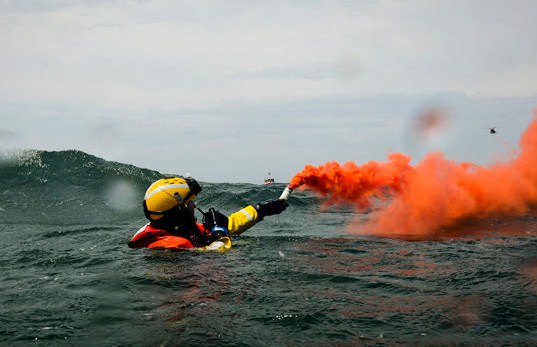Personal Flotation Device (PFD)
"SOUNDINGS"- July 20, 2017 Life Jacket Setup: Surviving a Fall Overboard
by Mario Vittone

When people fall overboard, more often than not it’s at the marina when stepping on or off the boat.
They slip or trip and end up in the water. The surprised swimmer is usually unharmed, except perhaps for a damaged ego, and is quickly recovered and made fun of. Fishing is another activity
that sees a lot of unplanned exits from the deck. But most people fish with friends, and the wet crewman is usually quickly recovered, unharmed, and made fun of. Fall off a vessel that’s underway, however, and everyone quits laughing. The most dangerous part of boating is unexpectedly falling overboard. How dangerous? If those left aboard lose sight of you, there is
a 40 percent chance you will never be seen again — dead or alive.
Read that again. I’m not trying to take the fun out of boating, but when to wear a life jacket and what to carry in its pockets is the most important discussion I’ve had with boaters. After a lifetime of looking for PIWs (persons in the water) and usually coming back empty, I’ve developed some rules about life jackets and their use. If you follow them, your chances of being rescued go way up.
Rule 1: Wear a life jacket with pockets Life jackets
have pockets for a reason, and it’s not to carry snacks. The best jackets
have loops of webbing or tabs inside the pockets for tying in gear (I’ll
come back to that). The idea is that if you don’t carry signaling gear and
other survival tools in your life jacket, you won’t have them if you fall
overboard. No one ever said, “I’m going over! Toss me a strobe light!”
Life jackets without pockets solve only half of your problem if you
end up in the water. Sure, you have to stay above the surface to stay
alive, but pockets hold gear that will solve the other part of your
problem: being found. If your current PFD doesn’t have pockets (this
is true of many inflatables, you
can often buy them to attach to the webbing belt. If you can’t, you’ve got
the wrong device. Get a new one.
Rule 2: Pack more than one thing, but always pack a
rescue beacon I’m often asked, “What is the one thing you should
always carry with you?” My first reaction is to say a life jacket with
more than one thing, but if I had to pick one it would be a personal
locator beacon, set up and registered correctly (tune in next week for how
to do that). A PLB that’s activated and attached to your life jacket
is the best guarantee — no matter what else happens — that someone will be
in your general area looking for you. AIS can’t guarantee that; it
requires other boats to be close enough to get the signal and be
AIS-equipped. A handheld radio can’t guarantee that. Your cell phone definitely
can’t. I know, PLBs cost more than most life jackets, but if you ever have
to activate it while alone in the water, you’ll think it’s the best money you ever spent.
Rule 3: Being found is about being seen — pack signaling gear A
brightly colored life jacket can be a signal, but only during the day. You
want something that you can actively use to attract attention. Carry at
least the following signaling gear:
Strobe Light: It’s best to have a water-activated strobe attached to the
upper shoulder of your vest, though keeping one in a pocket is better than
not having one. At a minimum, stuff a few 12-hour chemical lights in the
PFD.
Signal mirror: It may seem like a last-chance survival device, but a
mirror is lightweight, inexpensive and small, and it has unlimited range
and never runs out of battery power. Like whistles, a mirror falls into
the no-good-reason-not-to-carry-one category. Coast Guard-approved mirrors
are too big (4 by 5 inches, on average) to fit into most pockets, but the
sun doesn’t know the difference when it reflects off a smaller one.
Waterproof flashlight: This is my favorite. I carry two. Nothing turns
a helicopter around like a waving flashlight. Strobe lights have a range
of about 3.5 to 4 miles, but the focused beam of a strong flashlight can
reach almost anything on or above the water.
Rule 4: Make sure your hands aren’t required You will be opening
pockets that are under the water, and you might be working in the dark.
The gear must be tied into or onto the vest. If you drop something, it’s
gone. The Coast Guard had us tie our gear in with 36-inch lengths of nylon
cord. It always served me well and seemed like the correct length. Devices
such as strobes and PLBs must be securely attached as high above the water
as possible. You won’t be able to hold to either device for long, and just
because some beacons float doesn’t mean they work well when floating. The
antenna must be high to effectively transmit a signal. Of course, none
of this will help if you aren't wearing a life jacket when you go over.Going overboard is the most
dangerous part of boating. Choose your life jacket and set it up as if you
knew you were about to fall overboard. Plan on it. The gear you leave on the
boat won’t be of any help once you’re in the water.